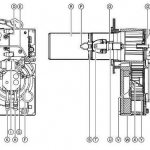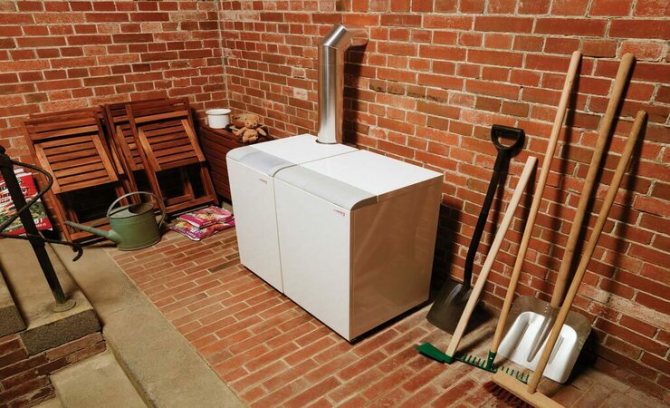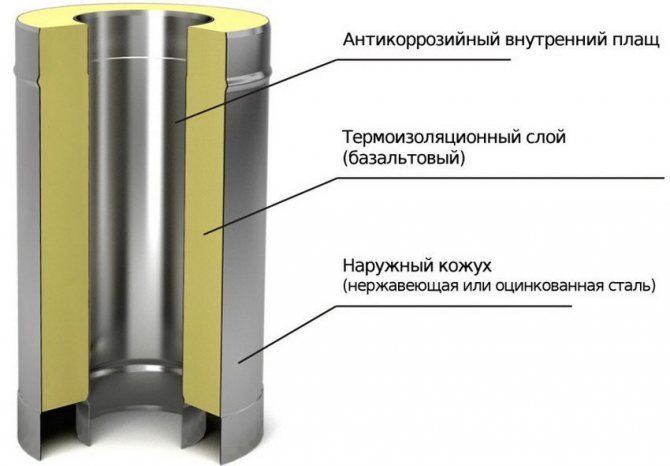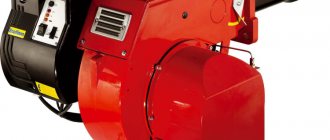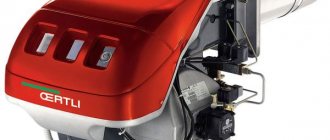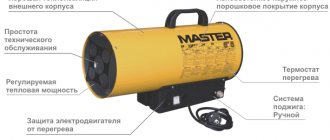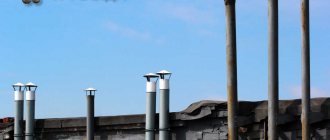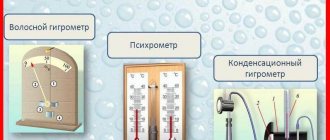Device and principle of operation
As mentioned above, liquid fuel heating boilers are structurally similar to two-pass and three-pass gas boilers. By virtue of their design, the products are manufactured in floor-standing design.
For reference. In boiler systems with a fire-tube heat exchanger, the combustion products can change the direction of movement several times, making several passes through the fire tubes and intensively giving off heat to the water jacket. According to the number of strokes, the heat exchanger is assigned a characteristic - three-way or two-way.
The similarity lies in the design of the heat exchanger made of flame tubes enclosed in a water jacket. In the very center there is a chamber for burning fuel, only for a diesel unit it has a cylindrical shape. This is due to the design features of the burner using liquid fuel. The main elements and details are shown in the figure.
the device of the Viessmann oil-fired boiler
A - external heat-insulating shell; B - heat exchange surfaces of the flame tubes; C - combustion chamber; D - electronic control unit; E - burner device.
In the products of leading foreign manufacturers, the firebox is made of heat-resistant stainless steel; low-cost domestic heat generators can also be made of ordinary thick metal. The material of the heat exchanger is cast iron or steel; basalt fiber or dense polyurethane foam is used for thermal insulation. A burner that runs on liquid fuel and is of particular interest, its design with an explanation of the elements is shown below.
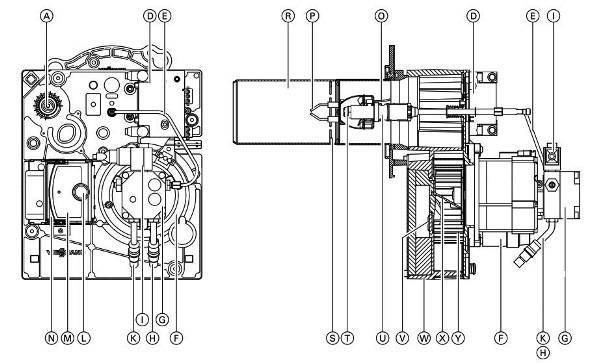
Diesel burner drawing
A - throttle valve for air regulation; D - block of ignition system with flame control sensor; E - fuel line; F - fan motor; G - pump; K, N - supply and return pipelines for fuel; І - electromagnetic valve; L - button for resetting the malfunction signal; M - automatic heating control; N - console; О - ignition cable; Р - electrodes of the ignition system; R - cylindrical working part; S - mixing device; T - nozzle; U - rod with fuel heater; V - air intake device; W - burner body; X - air channel; Y - fan impeller.
The working part is made in the form of a cylinder with many holes, through which the flame passes. When the fuel is burned, the burner flame heats the cylindrical walls of the furnace, as shown in the photo.
Oil burner operation
A special container is intended for the fuel, it can be free-standing or suspended from the wall, a supply line is laid from it to the burner. Some burners have a return fuel line to relieve pressure, then the installation of the boiler and its connection are provided for by two pipes - supply and return, going to the tank with fuel. Ignition is carried out in automatic mode at the command of the control unit.
Additional selection criteria
- The presence of a soundproof casing. Not available on all oil burner models. During the operation of the boiler, the module creates a certain background noise; this is inevitable, given the specifics of functioning (boost). You need to focus on the location of the heating equipment; if it is mounted in a furnace (annex, shed), it does not matter. But when installing in the basement, it is worth considering.
- Injector type.The engineering solution affects the efficiency of the injector, the completeness of combustion of liquid fuel and, as a result, the frequency of maintenance of the module.
- Heating system. Not all burners have it. Taking into account the specifics of the Russian climate, it is advisable to purchase units with this function.
Otherwise, you will have to switch to winter types of liquid fuel (they are more expensive), but this does not guarantee the stability of the flame, especially with regular changes of modes. The only exception is for cases when the fuel tank is located in the annex, but this is extremely rare.
The acquisition of the optimal burner for an oil boiler is an assessment of not only all of its parameters and capabilities. It is necessary to take into account the features of the heating system: the dimensions of the combustion chamber (if we are talking about the built-in module), the maximum power, the level of automation. It is worth asking about repair statistics - only a specialist knows which manufacturer's units are reliable. Tips, recommendations of a professional will be extremely useful.
Alfatep.ru is an online store where the buyer will find the desired modification of the burner for the oil boiler. Direct supplies from manufacturers keep prices low. All modules are of high quality - only from well-known brands. Our employees are ready to answer any questions regarding the choice of components for heating equipment, to recommend the best option; hotline telephone. Thanks to a developed network of representative offices and built logistics chains, we guarantee that the client will receive the purchased goods as soon as possible, regardless of the region of residence.
What are long-burning coal-fired boilers for private houses
A long-burning coal boiler is a modern heating device designed to generate heat energy and then heat the coolant by burning certain types of solid fuels, mainly coal and brown coal, anthracite, coal briquettes, etc.
Application and effectiveness
Solid fuel boilers do not need an advance design of a construction project, therefore they are used everywhere - not only for the formation of a new one, but also for the modernization of an existing heating system in a room (for domestic, industrial and commercial purposes).
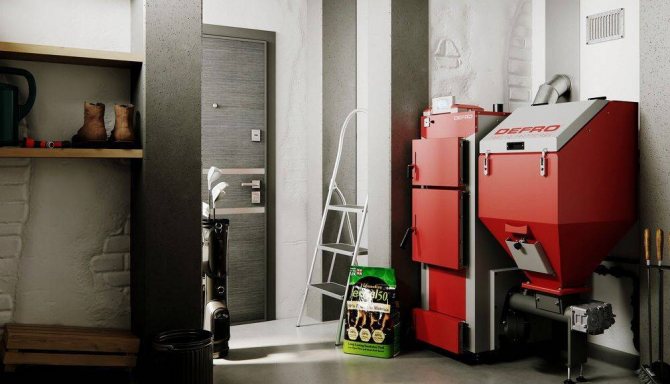

Coal operation does not imply dependence on network communications, therefore such boilers are ideal for private houses located in non-gasified areas. In such conditions, they fully reveal their potential, since, if desired, they can be adapted for the preparation and heating of water.
The efficiency of long-burning coal-fired boilers reaches 80–87% (against the standard 70–75%), but they cannot be called a very cheap heating option.
Comparison of the efficiency of long-burning coal-fired boilers (table):
| Main resource | Calorific value, mJ (kW) / kg (m3) | Fuel price, RUB / t (m3, kW) | Efficiency | The cost of kW of heat, rubles |
| coal | 22,1 (6,2)–27,6 (7,7) | 6000–7000 | 80–87 % | 1,04–1,20 |
| coal anthracite | 28,3 (7,8)–31,1 (8,7) | 8000–8500 | 80–87 % | 1,12–1,28 |
| natural gas | 33,5 (9,3)–36,5(10) | 5400–5700 | 90–95 % | 0,60–0,64 |
| chopped firewood | 11,2 (3,1)–14,3 (4,0) | 1500–1800 | 60–65 % | 0,69–0,80 |
| electricity | 3,6 (1) | 2.5-4.3 (tariff) | 98–99 % | 2,55–4,34 |
As can be seen from the table, gas boilers are the most profitable from a financial point of view. When burned, gas is converted into thermal energy almost completely, so there is no need to “waste” pay for waste, which is inevitably generated when burning any solid fuel.
The cost of firewood is also lower than coal, but in the long term, such heating still loses: since wood has a lower density and mass, with the same volume of the furnace, a full load of firewood (even taking into account the increase in burning time) is enough for 8-48 hours, and coal burns up to 1-7 days.
Device and principle of operation


The principle of operation of a long-burning coal-fired boiler on the example of the Stropuva S20 model.
The device of long-burning coal-fired boilers is generally similar to any other solid fuel units, but it has some features:
- loading chamber - occupies almost the entire internal space of the cylindrical body, which explains the increased capacity of the boiler;
- the entrance to the firebox is necessarily located in the upper third of the loading chamber, while the door itself can be located both vertically and horizontally;
- the air chamber is also a recuperator, due to which the air in it heats up and enters the combustion zone already hot;
- movable distributor - is a flat metal "pancake" required for metering air on the fuel combustion surface;
- telescopic duct - looks like a dynamically lengthening tube that connects the air chamber and the distributor;
- ash pan - is placed as a standard in the lower part of the body, but no longer plays the role of a blower, as in conventional boilers, therefore it must be hermetically closed;
- chimney - has a "broken" (knee) shape, so the smoke, passing through it, better accumulates heat and is discharged into the chimney already cooled;
- heat exchanger - "water jacket" is built into the boiler body; it (unlike a coil) surrounds the combustion chamber and the flue duct around the entire perimeter.
At first glance, it may seem that a long period of continuous operation is achieved by increasing the loading chamber, but this is not entirely true.
The principle of operation of such boilers is to implement "upper combustion": for this, air is supplied not from below - through the grate, as in conventional boilers (direct combustion), which operate on natural draft, and from above - through an air duct, using forced flow.
In such conditions, the combustion process becomes completely controllable: it is active only in the air supply zone and almost does not affect the bulk of the fuel. In fact, combustion is reduced to layer-by-layer smoldering (without a flame) - from the upper layers to the lower layers, which provides a more uniform heat transfer.
Visual process of long-term burning of coal.
Boiler location
The regulatory framework that would regulate the installation of a solid fuel boiler in a private house has not yet been developed. Nevertheless, the basic requirements for the placement of such equipment can be found in SNiP "Heating and Ventilation" and SNiP 31-02-2001 "Single-family houses" (for the Russian Federation), as well as a number of other individual acts.
It is worth noting that the SNiP "Boiler Installations", often mentioned on the Internet, is not designed for household appliances of low power - its requirements apply to equipment with a capacity of more than 360 kW, and the rules for installing gas equipment are too strict.
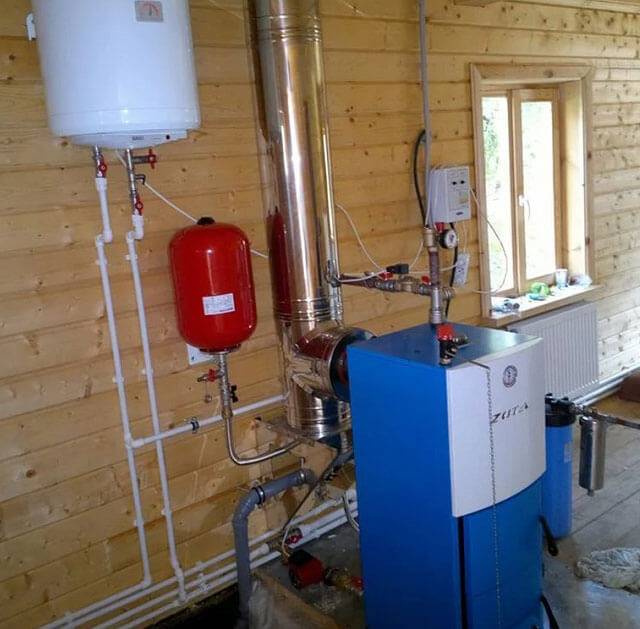

Based on the analysis of the available regulatory framework, which relates to the procedure for placing heating devices on wood, the following tips can be distinguished on how to install a solid fuel boiler in a house:
- Any type of solid fuel, be it wood, coal or pellets, creates a lot of dust. In addition, during the operation of the boiler, different amounts of smoke can enter the room. In this regard, it is not recommended to install a solid fuel boiler inside the living rooms of the house. Although the regulatory framework does not directly prohibit the installation of a solid fuel boiler in the kitchen, corridor or other rooms, with the exception of the bedroom.
- The best option for placing a solid fuel boiler will be an equipped separate boiler room or a boiler room attached to the common house. You can also stop at technical rooms in the house itself, basement, garage or corridor with good ventilation.
- Heating equipment should be located as close to the outer wall as possible in order to facilitate the laying of the chimney, not create too long a horizontal section or not lead the pipe through the ceiling.
- Any solid fuel boiler needs periodic cleaning of the heat exchanger and maintenance. Therefore, it is necessary to provide free access to it. To do this, at least 1 m of space is left in front, and about 60 cm at the back and sides, but at least 25 cm.
- It is forbidden to connect the gas flue of a solid fuel boiler to brick ventilation ducts inside the walls.
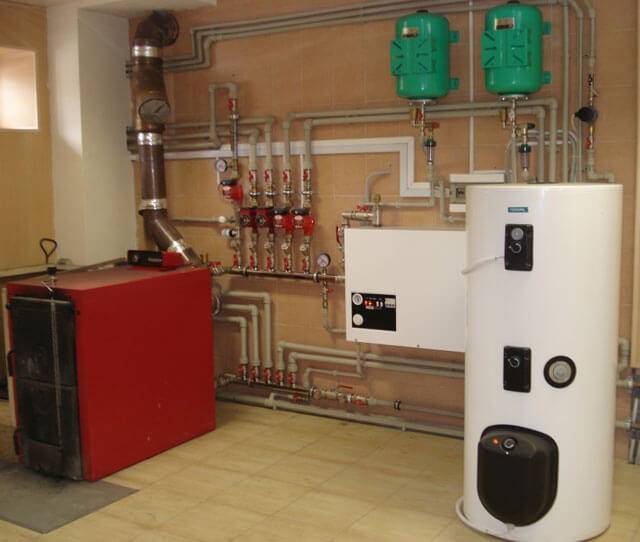

In small-sized boiler rooms, it is possible to place heating equipment close enough to the wall, but only on the unattended side. In this case, the gap can be at least 10 cm, and at least 25 cm must remain behind.
Gas-burner
It is almost impossible to imagine life in megacities today without gas burners. It is they who provide guaranteed heat and hot water at times when it is not in houses without gas supply. The areas of application of gas burners for boilers are quite extensive. These are ordinary administrative premises, residential complexes, and industrial or agricultural facilities.
Why it turns out that buying a gas burner for a boiler is much more practical than a liquid fuel analogue?
- This option is economical to operate, since gas fuel is cheaper today than liquid fuel;
- The ease of installation and use of gas burners, as well as many parameters and characteristics, make it one of the best ways to heat premises;
- The power of the gas burner allows it to be installed even in large rooms that are not capable of heating other heating equipment.
The sale of gas burners for boilers is one of our main directions. Therefore, we understand all the features of this heating element. Our experts are always ready to advise you which of the burners is better to install on your boiler, how to regulate its power and how the types of burners differ from each other:
- an atmospheric burner copes well with heating small rooms, since its power is low;
- the fan burner has a temperature control function, therefore it is more expensive than the previous version. The powerful fan, which is built into its case, is large, so it is worth installing such equipment in a large room.
Also, burners are divided into two types according to the type of power regulation: one- and two-stage. It is also important to pay attention to this parameter, since too much power can damage the boiler.
Resistant and durable materials from which our gas burners are made will allow you to purchase a heater once and for almost centuries. With proper care, a gas burner can last more than 40 years and warm not a single cold room.
Recommendations for choosing diesel boilers for country houses
- Heat exchanger type - boilers are offered equipped with a cast iron or steel heat exchanger.
- Features of work - boilers on diesel fuel for heating private houses, country cottages, are produced in the classic version, designed for connection to high-temperature heating systems. Leading leaders in the production of boiler equipment, have developed condensing boilers, characterized by high efficiency and economy and working with heating systems , low temperature type.
- Automation and control unit. Diesel boilers operate as fully autonomous and independent heating stations. As an option, a remote control and notification unit is provided. Control over work processes is carried out through any mobile device.
- The number of contours.
- Performance.
- Manufacturer's brand.
- Cost.
Single-circuit or double-circuit diesel boiler
- Single-circuit boilers are large-capacity models designed for connection to the heating system. The possibility of heating hot water is not provided. If later, it is required to connect DHW, an indirect heating boiler is built into the heating system. The advantage of single-circuit models is the ability to heat large houses.
- Double-circuit boilers - the device provides DHW and heating circuits. Depending on the manufacturer, a bithermal or separate heat exchanger is used in the design. Modern models are equipped with a built-in storage tank. The advantage of this design of a diesel boiler on diesel fuel is the instant supply of hot water to the consumer, immediately after opening the water supply tap.
What brand of diesel fuel boiler to choose for home
- The rating of boilers is traditionally headed by the products of German companies. Brands stand out favorably:
- Buderus Logano G125 and G225 series,
- Viessmann Vitorondens,
- Vaillant iroVIT VKO.
- French boilers are in no way inferior in quality: Judging by their popularity with European consumers, De Dietrich managed to create serious competition for boilers made in Germany.
- A domestic buyer prefers cheaper brands made in Italy:
- Fondital Capri series RTF and RTFD,
- Nova Florida series BTF and BTFD, RTF and RTFD.
- Korean:
- Kiturami STSO and Turbo series,
- Olympia OLB.
- There are products that have recently appeared on the heating equipment market, but have already gained popularity:
- DanVex B (Finland),
- EnergyLogic EL (USA).
Burner design and principle of operation
Typical schemes for the operation of ZhTG are, in principle, similar for different types of boilers. By design, they can be made in block and monoblock.
In modular units, diesel burners for boilers are included in the basic delivery with the boiler, other parts of the fuel system: pump, tank and heat exchanger are supplied separately.
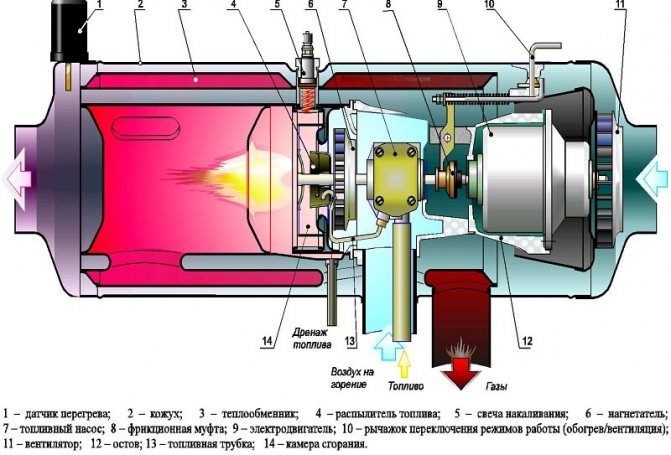

This allows, due to the combination of various units, to perform the fuel economy as efficiently as possible, taking into account the real conditions of the heat supply source.
This configuration is usually used in large industrial boiler rooms. Monoblock burner for diesel fuel is a completely ready-made complex for operation. All that is required is to adjust the VTG operation.
Operating principle of diesel burners:
- From the fuel tank, where the diesel fuel is stored, it is pumped into the supply line to the ZhTG under operating pressure.
- The pump has a recirculation line to dump diesel fuel that is not used by the VTG into the tank.
- A diesel cleaning system is installed on the fuel supply line, consisting of coarse and fine filters.
- For fuel with high viscosity, a heating system is installed - a special heat exchanger, where the fuel is heated to 95 C. The heating source can be hot water or steam from the boiler room.
- Well-prepared fuel enters the nozzle, which sprays diesel fuel into the smallest droplets and throws it under high pressure into the combustion chamber, where it is ignited with a special igniter. Coming up, the mixture is drawn into the combustion area and mixed with air, which ensures complete combustion.
- Air is supplied to the furnace by a fan, control is performed by primary sensors that regulate the volume of supply by the speed of rotation of the electric motor or by the air damper guide vanes.
- Flue gases move along the chimney duct, thanks to the vacuum created by the smoke exhauster. Its operation also takes place in automatic mode, the primary sensors monitor the pressure drops in the gas path of the boiler and give a signal to "open-close" the flue gas damper.
Features of fuel loading and operation
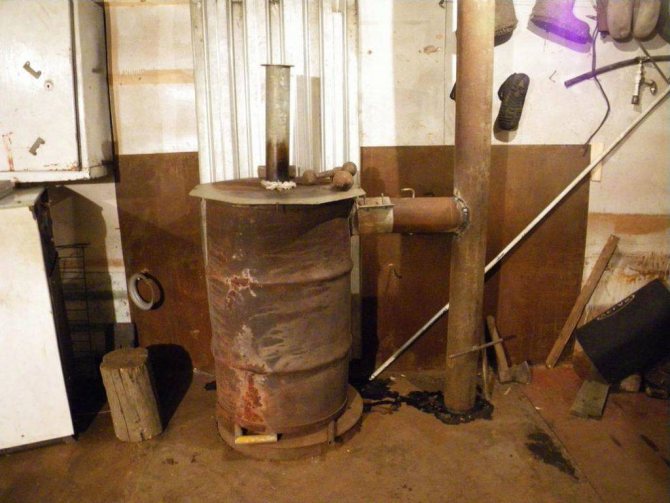

Heating system assembly
From a simple boiler, where a full-fledged air supply is needed throughout the entire volume of fuel combustion, the design of long-term combustion, as noted earlier, differs in the limited supply of this supply. Moreover, the volume of loading directly affects the combustion time, therefore, in our case, the furnace is loaded extremely tightly so that there are no gaps.
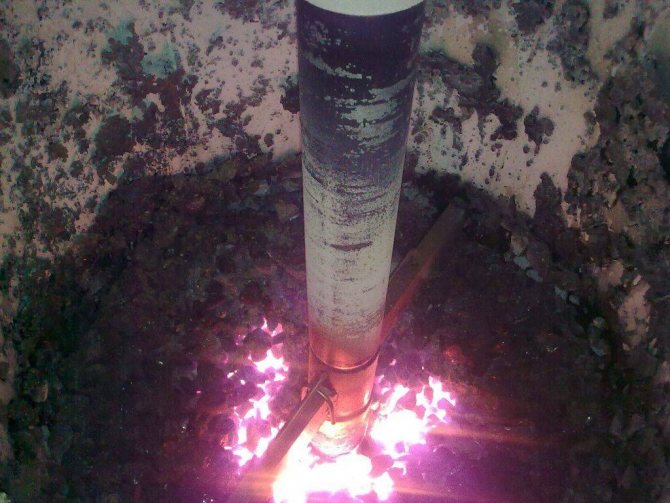

Firebox from the inside
The fuel is loaded in this sequence.


Boiler loading
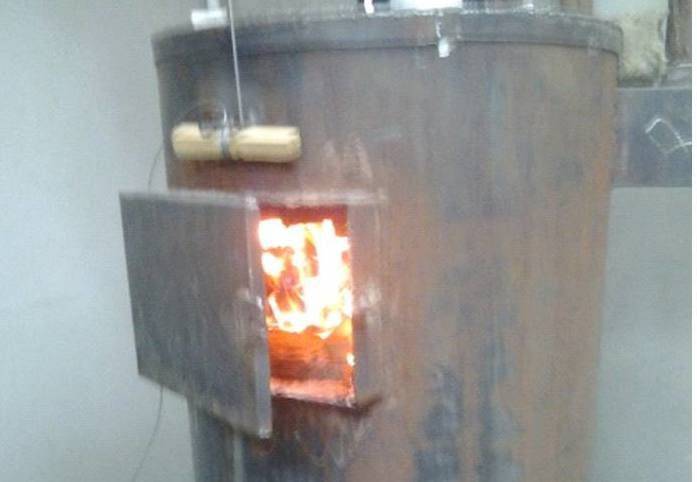

Trial boiler firing
Step 1. The top cover of the structure is removed.
Step 2. Remove the air regulator.
Step 3. The boiler is loaded with fuel up to the level of the chimney.
Step 4. From above, the fuel is poured with a small amount of ignition fluid (diesel fuel, used oil, etc.).
Step 5. The air regulator is put back and the cover is put on top.
Step 6. The air damper opens to the limit.
Step 7. A piece of paper is set on fire and thrown into the structure. When the fuel starts to smolder, the choke closes.
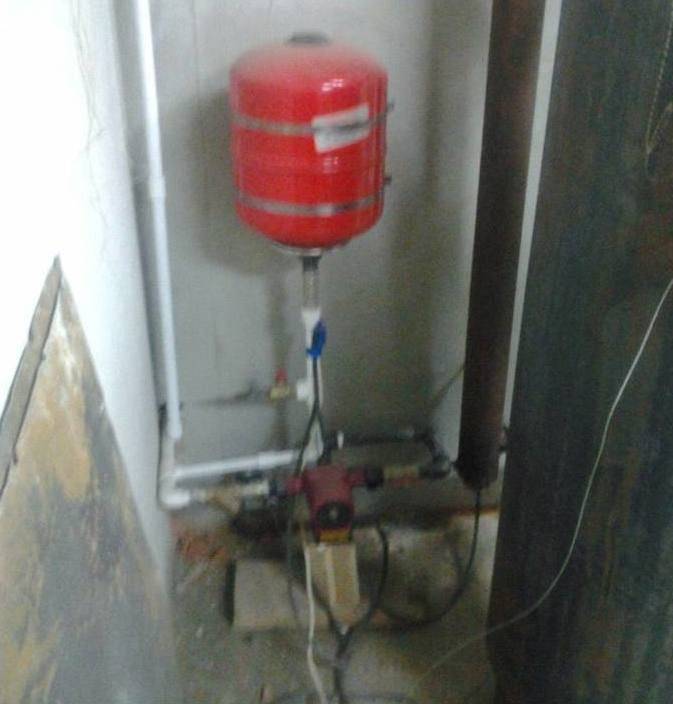

Heating system. Strapping


Heating system. Strapping
The fact that permanent combustion has begun can be judged by the smoke emerging from the chimney. As the fuel burns, the pipe of a smaller diameter will go down together with the air regulator - using this kind of indicator, you can determine the amount of remaining fuel.
Oil fired boiler
In principle, a liquid fuel boiler (or several paired boilers) can be used as a boiler station, but then it is more profitable to heat it with fuel oil, because with the same consumption of fuel oil and gas, the specific heat released from gaseous fuel is much less. There is, however, one sin in such heating devices, which not that spoils the overall picture, but makes one think about the fundamental installation. We are now talking about ignition (start of operation), which is the basis for the operation of the boiler and the beginning of the heating season. It is no secret that any hydrocarbon is ultimately a combustible material (some require appropriate processing), but, unlike gasoline, oil and diesel fuel start the combustion process from higher temperatures (this can be seen if you try to light a few drops of gasoline from a match) and fuel oil).
Liquid fuel boiler design
That is, all other things being equal, heavier hydrocarbons have a higher ignition temperature, from which it can be concluded that the design of a liquid fuel boiler should have a pilot igniter and refractory elements of the heat exchanger with a serious duration of combustion. Diesel fuel, fuel oil and oil provide stable and long-term combustion provided that fuel is systematically added to the combustion chamber.
The simplest device for a liquid fuel boiler
The easiest option for understanding and describing the properties of such types of boilers is a do-it-yourself stove with a dropper. A standard furnace for stoves has a door for kindling with ordinary wood, and at the top there is a steel drip chamber through which the fuel enters the combustion chamber directly. To ignite the unit, it is necessary to flood it like an ordinary stove, let it warm up, and then open the dropper to a minimum. Adjusting the dosing of liquid fuel automatically increases or decreases the combustion temperature, and the combustion force (intensity) is controlled by a blower (supply ventilation). The smaller the volume of incoming air, the weaker the combustion, the safer the fuel and the more stable the heating temperature.
Heating on liquid fuel can be organized only with an uninterrupted supply of fuel, therefore it is not recommended to extinguish boilers on liquid fuel for a short time (only for the summer period).The creation of conditions for the correct supply of flammable liquid and the timely replenishment of the stock in the tank creates another nuance - a characteristic smell.
Advantages and disadvantages
Among the qualitative and technical indicators, there are no unambiguous minuses or pluses, since some, at first glance, negative features may be for the sake of expanding the list of positive aspects. Everything has already been discussed in the article, but it will not be superfluous to recall and classify all the nuances.
So the pros:
- autonomy (in this case, we should talk about isolation from engineering systems and electricity);
- depending on what fuel can be used: if only one type is a minus, and if the boiler is represented by a combined system, this is a plus;
- stable combustion and maintaining an even temperature (provided that the dosage is the same, maintaining combustion, even with wind or precipitation, is not difficult).
As 100% cons, we note:
- heavy heating of the fuel to reach the ignition temperature;
- no pauses in the heater operation (unjustified fuel consumption);
- regulated minimum temperature in the system (each has its own and depends on the volume of the coolant, the size of the combustion chamber and the density of the hydraulic connection).
Diy waste oil boiler (video)
How does an oil boiler work
We have already mentioned the combustion procedure itself. We only note that during combustion, the walls of the furnace also warm up, as a result of which the water in the heat exchanger is heated. A chimney is equipped to remove gases. When gas enters it, it passes through a series of heat exchanger plates that accumulate heat and transfer it to the main heat exchanger. The efficiency of heating and the efficiency of the device increases dramatically from this.
When liquid fuels are burned, soot is generated due to simple chemical processes. It is for this reason that the user of the boiler must pay special attention to its maintenance. Regular cleaning of the combustion chamber from soot is required, in addition, the condition of the fan burner must be constantly monitored.
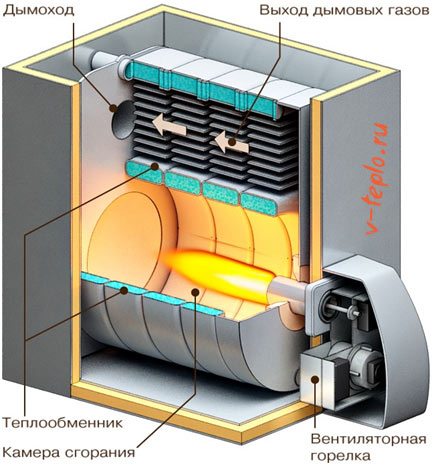

Important information! This burner is not supplied with the boiler, it must be purchased separately. Thanks to this, the boiler can be assembled based on the requirements and wishes of the owner himself. Moreover, if necessary, the burner can be exchanged for a gas one, after which the boiler turns into a gas heater.
Convenient enough, you must agree. Especially if there is no gas pipeline nearby, and liquid fuel is used temporarily. The burner itself can be of two types:
- built-in;
- removable.
You may also be interested in an article on drawing up a boiler regime map
Built-in burners are installed "once and for all", that is, you cannot change the type of fuel. Removable burners are another matter, which truly make this device universal.


In general, the boiler structure looks like this:
- combustion chamber;
- chimney;
- cast iron or steel heat exchanger;
- fan burner.
General information about working boilers
The concept of recycling spent fuel materials has been around since the beginning of the problem of utilizing oily waste. However, in boiler equipment, such an approach has found a full life only recently - since the development of pyrolysis technologies and long-term combustion systems by large manufacturers. These developments are more likely related to the recycling of gas mixtures from solid fuels, but their principles can be transferred to the concept of waste oil boilers. For oil, in this case, a special burner is used, connected to an inversion combustion chamber and a smoke tube.


Of course, the main point of difference of this equipment from classical liquid fuel units is the used fuel raw materials.There is still a certain segmentation according to the type of technological development products used, but the future of such models belongs to universalization in terms of fuel supply. One way or another, waste oil boilers for the home mainly work at the expense of kerosene, diesel fuel and other diesel derivatives. Some modifications also support combustion when filled with vegetable oils and special heating oils. In the case of industrial models, we can talk about the use of coarse heterogeneous compositions with impurities.
Diesel fuel oil boiler
A widespread type of liquid fuel units - diesel fuel. They are inexpensive, highly efficient and easy to use. Household heating units using liquid fuel - diesel fuel - do not require special permission to be installed in a local heating network. They can be modified by hand: connected to the gas main.
The diesel heating unit has a design that includes:
- diesel burner;
- fuel filters;
- pump;
- separate control panel for the automated system;
- safety sensors for maintaining stable combustion and the required temperature of the coolant in the system.
- The fuel is mixed with air in an inflatable burner.
- Mixed with air, it passes into the combustion chamber thanks to a powerful fan, where it burns.
- The coolant heats up, like the walls of the chamber in which it is located.
- The gases formed in the process of functioning leave the system of the device through a special chimney provided by the design.
Due to the fact that the boiler on diesel fuel is not much different from the gas one. and it is possible to reconfigure it with your own hands, since the key difference lies in the type of burner. But their modification with their own hands is possible only for diesel fuel boilers with a hinged burner. This trick won't work with the built-in one.
Do-it-yourself refurbishment of the furnace with the help of the parts included in the boiler package should only take place according to the proposed drawings and nothing else.
Some manufacturers create 2-in-1 liquid fuel heating boilers that can operate on both diesel and gas. Mostly they are floor-standing. Before purchasing a diesel boiler for the heating system of a private house, it is imperative to calculate the fuel consumption of the device and its heating capacity.
This is easy to do, thanks to the formula: boiler power in kW / 10 = kg of fuel per 1 hour of operation. For a region with average climatic conditions, 3 tons of solarium will be required to supply a building with an area of 300 m 2 with a heat carrier. On average, 0.1 l / hour per 1 kW of device power. Consumption may vary depending on the temperature needs of residents - if someone feels comfortable at a temperature of 22-24 ° C, then for others the optimal temperature will be from 25 ° C. And the higher the temperature, the greater the fuel consumption.
Advantages and disadvantages
Like all heating boilers, liquid fuel appliances have both advantages and disadvantages.
Among the advantages it should be noted:
- the ability to use this type of heating units for heating residential buildings, industrial enterprises, production workshops, etc.;
- independence from the centralized heating system and the presence of the main gas pipeline;
- autonomous functioning;
- well-tuned automated regulation, which allows the boiler to operate in an uninterrupted mode;
- uncomplicated maintenance and minimal need for repairs or replacement of component parts;
- high efficiency - about 95%;
- during the operation of the boiler, there is almost no noise and smell;
- safety of functioning of a correctly installed heating unit;
- due to complete autonomy, it is possible, if necessary, to turn on the heating at any time.
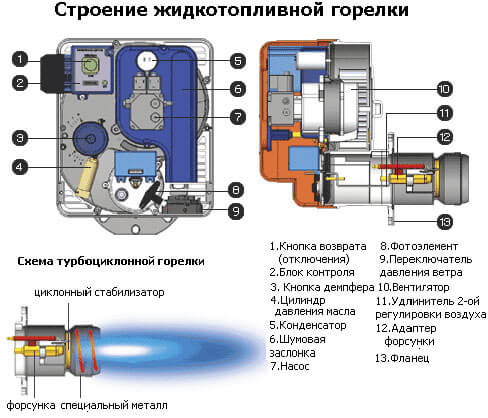

The main disadvantages of the units:
- liquid for heating boilers must be stored in a specially equipped place in an appropriate container;
- the cost of such heating equipment is not available to everyone, its price is higher than that of solid fuel similar devices;
- for the installation of liquid fuel heating units, it is necessary to allocate a separate room where the chimney should be installed. We can say that it will be necessary to equip an autonomous boiler room, and this event requires additional financial and physical costs;
- liquid fuel, although insignificantly, is more expensive than similar carriers of thermal energy;
- to ensure uninterrupted operation of the boiler over a long period of time, it is necessary to provide a large fuel tank. Based on this, special attention should be paid to the arrangement of a separate boiler room.
To summarize, the conclusion is obvious: the advantages of liquid fuel boilers are more significant than the disadvantages. Thus, it is possible to ensure the efficiency of the operation of such a heating unit with significant financial investments.
Varieties of diesel boilers
So, due to the inability to use other common energy sources, you decided to arrange heating on liquid fuel in your home. It's time to choose a heating boiler, and then you need to figure out what types of these products exist and choose the most suitable option. Manufacturers offer heating boilers for liquid fuel of the following types:
- diesel boilers;
- universal units, they provide for the possibility of switching from diesel to natural gas;
- condensing boilers for diesel fuel;
- installations that burn all types of waste oils.
If in the foreseeable future no change in the situation with energy resources is foreseen, then your option is to heat a private house with a heating boiler of the first type, burning only diesel fuel.
For reference. Most of these installations can operate on liquid biological fuel, which is obtained from industrial crops (biodiesel). This option can be very useful if such an energy carrier is available to you.
Some homeowners looking for a boiler for heating believe that in a diesel boiler they will be able to burn and work off their car. This is the wrong approach, and for the following reasons:
- Not every burner operates on contaminated oils.
- The calorific value of liquid fuel is much higher than that of waste oils. Accordingly, the areas of the heat exchange surfaces are calculated for liquid fuel; during the combustion of the development, the efficiency will be much lower.
- The combustion workout emits significantly more soot, which settles in the entire smoke path. This can be a big problem in the maintenance and cleaning of fire tubes.
By their design, liquid fuel boilers are very similar to heat generators operating on natural gas. Accordingly, many manufacturers offer universal hot water installations with alternating use of liquid and gaseous fuels. The transition from one type of fuel to another is carried out by replacing the burner device. True, a universal boiler that runs on liquid fuel and main gas will cost you a little more.
If the area of the heated room or building is less than 200 m2, and in the near future you expect to be connected to the gas pipeline, then you should not rush to purchase a universal heater.
The fact is that the cost of a boiler block and two burners may turn out to be higher than two separate full-fledged units. Therefore, at first, you can put the boiler on diesel fuel, and after connecting to the mains, buy and install a gas heat generator. You can find out more information by watching the video:
Domestic condensing boilers for diesel fuel are the most economical and efficient representatives of this family of heat sources. Manufacturers declare the efficiency of their condensing units at 97%, which is the highest among all other heaters. As usual, their cost is quite high and not every owner can afford to include such a high-tech product in the heating system.
It is very good if you have access to such a secondary resource as used car oil in sufficient quantities. Then especially for this purpose there is a waste oil boiler, the product is manufactured and offered on the market by many manufacturers. Also, similar boilers for heating are well mastered by various craftsmen who make homemade heaters.
Varieties of diesel burners
There are many modifications of oil burners, which are mainly produced by boiler manufacturers. In small household heat power engineering, it is possible to use such burners from different manufacturers, if their characteristics match the installed boiler unit.
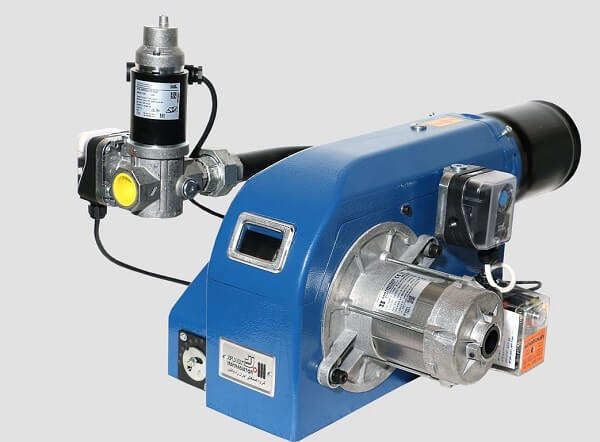

If the boiler is supplied without a burner, then the equipment manufacturer must indicate their permissible modifications and characteristics. Unauthorized installation of them is not allowed, since this can cause an imbalance in the thermal balance of the boiler with subsequent burnout of pipes and an explosion.
Diesel burners are classified by power:
- Single-stage are considered to be the simplest in principle of operation and design. Since they are single-mode, the boiler heat output is controlled only by turning on or off the diesel supply. The advantage of such devices is low cost and ease of maintenance. Disadvantage - reduces the operating time of the boiler due to frequent shutdowns.
- Two-stage devices usually operate in two modes: 50% and 100%, respectively, for the spring-autumn transitional climatic period and the maximum winter. Despite the fact that such modifications have a high price, they quickly pay off due to the low cost of the generated heat energy, due to the absence of fuel burnout and the durability of the boiler equipment.
- Modulated devices are capable of operating automatically in the range from 10 to 100% with high efficiency and low chemical underburning losses. Such modern variations of liquid fuel burners (ZhTG) have a very high price, however, they quickly pay off, by reducing the operating costs of boiler maintenance.
In addition, there are models of gas-oil burners that are capable of operating on both gas and liquid fuels. For this, only the removable nozzle in the ZhTG is changed.
Such designs are used in heat supply sources that use diesel fuel as a backup source, in the absence of a main gas supply.
